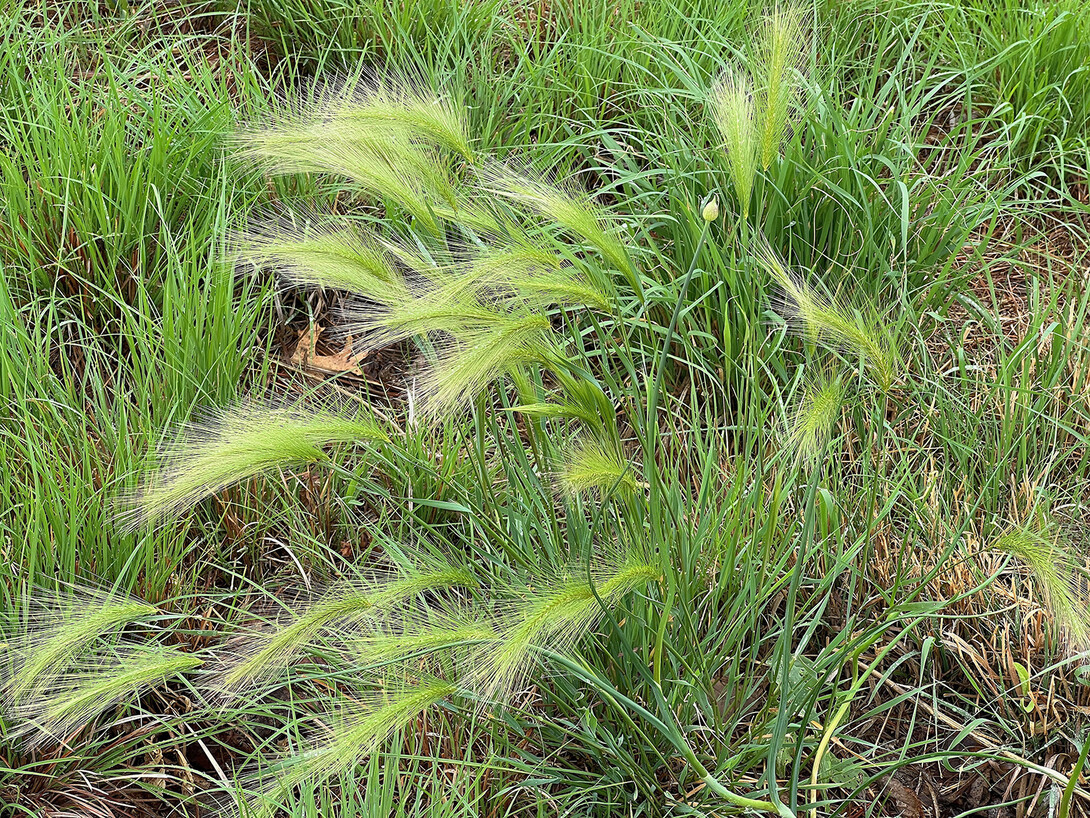
Early Detection and Rapid Response (EDRR) is a concept to identify potentially invasive species prior to or just as the establishment of the invasive species is taking place. An Integrated Pest Management plan (IPM) can be developed to manage, contain, and eradicate the invasive species before it can spread further. This will avoid costly, long-term control efforts.
Foxtail barley is a native cool-season bunchgrass. It is a short-lived perennial that has a shallow fibrous root system. Foxtail barley reproduces from seed and vegetatively by tillering. When mature, the plant can be one to three feet tall. Plants are gray-green to blue-green in color. Growth initiates in April and May; flowers and sets seed from June to August. Seed may survive up to seven years.
As a forage for horses, it has fair to good forage value until seed heads develop. During the vegetative state, before seed heads develop, it can be safely grazed. However, once seed head development begins, horses and cattle grazing Foxtail barley can be problematic.
When the seeds form, awns with small, sharp barbs along the edge extend from the seed. The awns can be up to two inches long with sharp barbs that point backwards. These sharp barbs allow the seed to lodge in the hair and fur of animals and be transported to new areas. The barbed awns can cause injury to pets, horses, and livestock lodged in their skin, eyes, nose, mouth, and digestive tract. Since the barbs point backwards, they continue to work their way deeper, potentially affecting organs and blood vessels. Affected areas may also form abscesses and become infected. Animals affected need to be treated immediately. Caution should be taken with hay containing the seeds and awns if fed to livestock.
Signs that a horse or livestock have grazed Foxtail barley or consumed hay contaminated with Foxtail barley may consist of drooling and a lack of appetite. Drooling and loss of appetite are caused by awns that are lodged in the mouth and most likely cause the mouth to become inflamed and sore, resulting in the formation of abscesses.
Foxtail barley should not be confused with green, yellow, or bristly foxtail (Setaria spp.), which are non-native summer annuals not closely related to Foxtail barley and are often a major weed in annual crops.
Early in the growing season, Foxtail barley is palatable, the forage value is fair to good, and can be safely grazed early, prior to seed development. Grazing after seed development is where the problems may occur. However, horses and other livestock typically avoid grazing Foxtail barley once seed head formation occurs if other forage is available.
Habitat
Foxtail barley can grow in most soil types and is an aggressive pioneer weed. However, it is saline and alkaline tolerant and is found most often in moist or wet areas, such as pastures, meadows, disturbed areas, ditch banks, and roadsides. Occasionally, it will show up in hay and grain fields. It can form monocultures and force out other vegetation.
Management
Prevention is the best and cheapest management option. Having well-established perennial grasses and forbs on maintained meadows, hayfields, and pastures, with proper grazing and rotational grazing techniques, can go a long way in preventing their establishment. Scouting, monitoring, and proper identification are key factors for management.
Currently, there are no biological control methods available.
Cultural and mechanical control measures include timed burning, hand pulling, mowing, and proper grazing management. Late spring burning has shown limited success. Hand pulling can be done if there are not too many plants. Mowing can reduce seed head production, but the plants will regrow.
There are limited chemical treatment options available to manage Foxtail barley, and the options available will depend on whether Foxtail barley is being managed in alfalfa, a cool-season hay crop, or a pasture. In alfalfa, glyphosate is available as the best management option in Roundup Ready® alfalfa. In conventional alfalfa, clethodim (Select Max®, Arrow® 2 EC) can be used but labels warn that multiple applications may be necessary for control. Products containing hexazione can be used at seeding, and products containing pronamide are labeled in the fall or winter, both providing residual control. In grass hay, pasture, and rangeland, imazapic (Plateau®) is labeled for control of Foxtail Barley, but care must be taken to ensure that the grass grown for hay or forage is tolerant to imazapic. The success of chemical control declines if it is sprayed later in the growing season, after seed heads have become established.
Be sure to select a product labeled for the site and target pest. Use of product brand names is for information purposes only and does not imply endorsement by the University of Nebraska-Lincoln. Read, understand, and follow all label instructions when using any pesticide.
References
Collins, R., Guthrie, T., 2013. “Foxtail barley in and around horse pastures.” Michigan State University
DiTomaso, J.M., G.B. Kyser et al., 2013, “Weed Control in Natural Areas in the Western United States”, Weed Research and Information Center, University of California, 544 pp.
Filley, S., “Foxtail Control in Pastures and Hayground,” Oregon State University
“Foxtail Barley,” ProVMWeb, 2015, Univar
Matney, C., “Foxtail Barley,” Colorado State University, Fact Sheet 3.109







